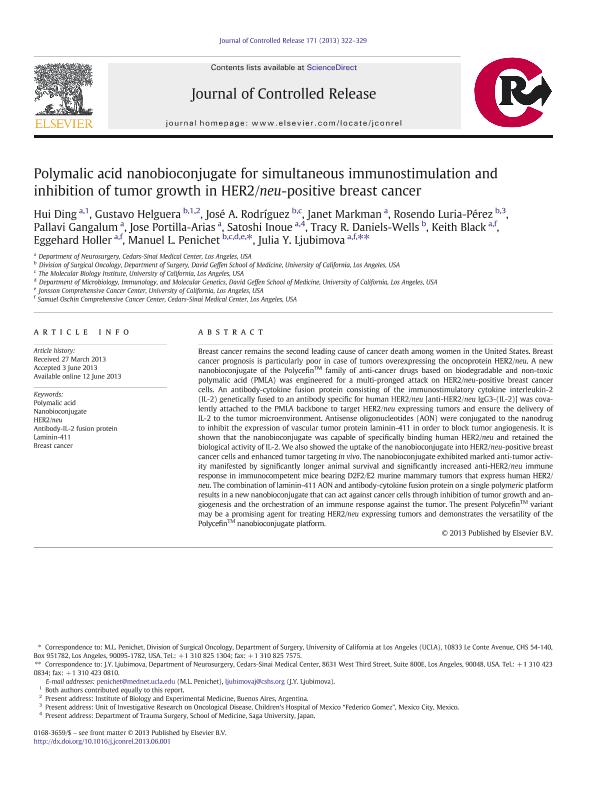Mostrar el registro sencillo del ítem
dc.contributor.author
Ding, Hui
dc.contributor.author
Helguera, Gustavo Fernando

dc.contributor.author
Rodríguez, José A.

dc.contributor.author
Markman, Janet
dc.contributor.author
Luria Pérez, Rosendo
dc.contributor.author
Gangalum, Pallavi
dc.contributor.author
Portilla Arias, Jose
dc.contributor.author
Inoue, Satoshi
dc.contributor.author
Daniels Wells, Tracy R.
dc.contributor.author
Black, Keith
dc.contributor.author
Holler, Eggehard
dc.contributor.author
Penichet, Manuel L.

dc.contributor.author
Ljubimova, Julia Y.
dc.date.available
2017-10-18T15:55:26Z
dc.date.issued
2013-06
dc.identifier.citation
Ding, Hui; Helguera, Gustavo Fernando; Rodríguez, José A.; Markman, Janet; Luria Pérez, Rosendo; et al.; Polymalic acid nanobioconjugate for simultaneous immunostimulation and inhibition of tumor growth in HER2/neu-positive breast cancer; Elsevier Science; Journal of Controlled Release; 171; 3; 6-2013; 322-329
dc.identifier.issn
0168-3659
dc.identifier.uri
http://hdl.handle.net/11336/26772
dc.description.abstract
Breast cancer remains the second leading cause of cancer death among women in the United States. Breast cancer prognosis is particularly poor in case of tumors overexpressing the oncoprotein HER2/neu. A new nanobioconjugate of the PolycefinTM family of anti-cancer drugs based on biodegradable and non-toxic polymalic acid (PMLA) was engineered for a multi-pronged attack on HER2/neu-positive breast cancer cells. An antibody-cytokine fusion protein consisting of the immunostimulatory cytokine interleukin-2 (IL-2) genetically fused to an antibody specific for human HER2/neu [anti-HER2/neu IgG3-(IL-2)] was covalently attached to the PMLA backbone to target HER2/neu expressing tumors and ensure the delivery of IL-2 to the tumor microenvironment. Antisense oligonucleotides (AON) were conjugated to the nanodrug to inhibit the expression of vascular tumor protein laminin-411 in order to block tumor angiogenesis. It is shown that the nanobioconjugate was capable of specifically binding human HER2/neu and retained the biological activity of IL-2. We also showed the uptake of the nanobioconjugate into HER2/neu-positive breast cancer cells and enhanced tumor targeting in vivo. The nanobioconjugate exhibited marked anti-tumor activity manifested by significantly longer animal survival and significantly increased anti-HER2/neu immune response in immunocompetent mice bearing D2F2/E2 murine mammary tumors that express human HER2/neu. The combination of laminin-411 AON and antibody-cytokine fusion protein on a single polymeric platform results in a new nanobioconjugate that can act against cancer cells through inhibition of tumor growth and angiogenesis and the orchestration of an immune response against the tumor. The present PolycefinTM variant may be a promising agent for treating HER2/neu expressing tumors and demonstrates the versatility of the PolycefinTM nanobioconjugate platform.
dc.format
application/pdf
dc.language.iso
eng
dc.publisher
Elsevier Science

dc.rights
info:eu-repo/semantics/openAccess
dc.rights.uri
https://creativecommons.org/licenses/by-nc-nd/2.5/ar/
dc.subject
Polymalic Acid
dc.subject
Nanobioconjugate
dc.subject
Her2/Neu
dc.subject
Breast Cancer
dc.subject
Antibody-Il-2 Fusion Protein
dc.subject
Laminin-411
dc.subject.classification
Ética relacionada con Biotecnología Médica

dc.subject.classification
Biotecnología de la Salud

dc.subject.classification
CIENCIAS MÉDICAS Y DE LA SALUD

dc.title
Polymalic acid nanobioconjugate for simultaneous immunostimulation and inhibition of tumor growth in HER2/neu-positive breast cancer
dc.type
info:eu-repo/semantics/article
dc.type
info:ar-repo/semantics/artículo
dc.type
info:eu-repo/semantics/publishedVersion
dc.date.updated
2015-08-14T18:17:05Z
dc.journal.volume
171
dc.journal.number
3
dc.journal.pagination
322-329
dc.journal.pais
Países Bajos

dc.journal.ciudad
Ámsterdam
dc.description.fil
Fil: Ding, Hui. Cedars Sinai Medical Center;
dc.description.fil
Fil: Helguera, Gustavo Fernando. University of California at Los Angeles; Estados Unidos. Consejo Nacional de Investigaciones Científicas y Técnicas. Instituto de Biología y Medicina Experimental. Fundación de Instituto de Biología y Medicina Experimental. Instituto de Biología y Medicina Experimental; Argentina
dc.description.fil
Fil: Rodríguez, José A.. University of California at Los Angeles; Estados Unidos
dc.description.fil
Fil: Markman, Janet. Cedars Sinai Medical Center;
dc.description.fil
Fil: Luria Pérez, Rosendo. University of California at Los Angeles; Estados Unidos
dc.description.fil
Fil: Gangalum, Pallavi. Cedars Sinai Medical Center;
dc.description.fil
Fil: Portilla Arias, Jose. Cedars Sinai Medical Center;
dc.description.fil
Fil: Inoue, Satoshi. Cedars Sinai Medical Center; . Saga University; Japón
dc.description.fil
Fil: Daniels Wells, Tracy R.. University of California at Los Angeles; Estados Unidos
dc.description.fil
Fil: Black, Keith. Cedars Sinai Medical Center;
dc.description.fil
Fil: Holler, Eggehard. Cedars Sinai Medical Center;
dc.description.fil
Fil: Penichet, Manuel L.. University of California at Los Angeles; Estados Unidos
dc.description.fil
Fil: Ljubimova, Julia Y.. Cedars Sinai Medical Center;
dc.journal.title
Journal of Controlled Release

dc.relation.alternativeid
info:eu-repo/semantics/altIdentifier/url/http://www.sciencedirect.com/science/article/pii/S0168365913003350
dc.relation.alternativeid
info:eu-repo/semantics/altIdentifier/doi/http://dx.doi.org/10.1016/j.jconrel.2013.06.001
Archivos asociados
